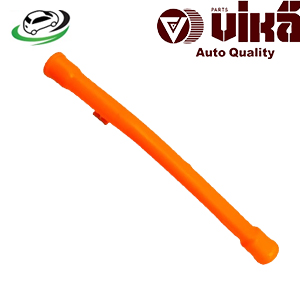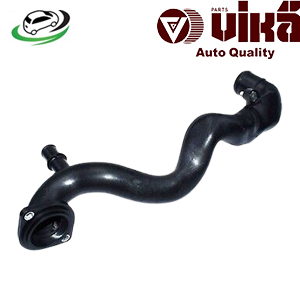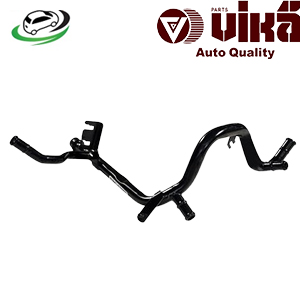-6%
Get Audi A3 Coolant Pipe 06A121065D
A coolant pipe is a tube that carries engine coolant—a special liquid designed to absorb heat—from the engine to the radiator and back again. The coolant pipe works as part of a closed-loop system, transferring the coolant through various sections of the engine to regulate the engine’s temperature.
These pipes are made from a range of materials, depending on the specific application and vehicle type, including rubber, metal (usually aluminum or steel), and plastic. Coolant pipes are designed to withstand high temperatures, chemical exposure from the coolant itself, and vibrations from the engine during operation.
2. The Function of the Coolant Pipe
The primary function of a coolant pipe is to carry coolant throughout the engine cooling system, where it absorbs excess heat and dissipates it through the radiator. Here’s how it works:
1. Transporting Coolant to the Radiator
- The coolant pipe carries hot coolant from the engine to the radiator. As the engine operates, it generates a significant amount of heat. Coolant absorbs this heat and then passes through the coolant pipes to the radiator, where the heat is released into the atmosphere.
2. Recirculating Coolant
- Once the coolant is cooled in the radiator, the coolant pipe plays a role in recirculating it back into the engine. This recirculated coolant absorbs heat again, repeating the process to maintain a stable engine temperature.
3. Preventing Overheating
- By efficiently transporting coolant throughout the system, coolant pipes help prevent the engine from overheating. If the engine overheats, it can lead to serious damage such as warped cylinder heads, blown head gaskets, or even a complete engine failure.
3. Types of Coolant Pipes
Coolant pipes come in various shapes, sizes, and materials, depending on their location in the cooling system and the specific design of the vehicle. The three most common types of coolant pipes are:
1. Rubber Coolant Hoses
- Rubber hoses are flexible and commonly used for connecting the radiator to the engine. These hoses can handle high temperatures and are resistant to wear. However, they may deteriorate over time due to exposure to heat and chemicals in the coolant.
2. Metal Coolant Pipes
- Metal pipes, typically made of aluminum or steel, are more durable and are used in areas where greater structural integrity is needed. Metal pipes are more resistant to cracking or bursting but are less flexible than rubber hoses.
3. Plastic Coolant Pipes
- Some vehicles use reinforced plastic coolant pipes, which offer a balance between durability and cost-effectiveness. While these pipes can handle moderate heat and pressure, they are more prone to cracking over time, especially under extreme heat conditions.
4. Key Benefits of Coolant Pipes
Coolant pipes provide several crucial benefits to the operation and longevity of a vehicle’s engine. Here are some of the most important advantages:
1. Efficient Heat Dissipation
- By ensuring that coolant moves smoothly through the system, coolant pipes allow the engine to shed heat quickly and efficiently, maintaining optimal engine performance.
2. Prevention of Engine Overheating
- Coolant pipes play a direct role in preventing overheating, one of the most common causes of serious engine damage. Properly functioning coolant pipes help the engine run at an optimal temperature even during extreme conditions, such as high-speed driving or towing heavy loads.
3. Prolonged Engine Life
- By keeping the engine at a stable temperature, coolant pipes contribute to reducing the wear and tear on internal engine components, which are highly susceptible to damage under extreme heat conditions. A well-maintained cooling system can extend the overall lifespan of the engine.
4. Cost-Effectiveness
- Maintaining the coolant pipes is significantly less expensive than repairing or replacing major engine components damaged by overheating. By investing in regular inspections and timely replacement of worn or damaged coolant pipes, drivers can avoid costly repairs down the line.
5. Common Problems with Coolant Pipes
Coolant pipes, like any other component in a vehicle, are prone to wear and tear over time. Some of the most common problems with coolant pipes include:
1. Cracks or Leaks
- Coolant pipes, especially rubber or plastic ones, can develop cracks or leaks over time due to exposure to high temperatures, pressure, and engine vibrations. A cracked pipe will allow coolant to leak out, leading to a drop in coolant levels and reduced efficiency in the cooling system.
2. Clogging
- Sediment and debris can build up inside the coolant pipe, restricting the flow of coolant and reducing its ability to dissipate heat effectively. Clogging is more likely to occur in vehicles that use low-quality coolant or do not undergo regular coolant flushes.
3. Corrosion
- Metal coolant pipes are susceptible to corrosion, especially in areas where road salt or harsh environmental conditions are prevalent. Corrosion can weaken the pipe structure, eventually leading to leaks or ruptures.
4. Detachment or Loosening
- Over time, the clamps or connections securing the coolant pipes to the engine or radiator can become loose or detached. This can lead to leaks or even complete separation of the pipe from the system, causing significant cooling issues.
5. Bursting
- In extreme cases, particularly during overheating or high-pressure situations, a coolant pipe may burst. A burst pipe can cause a sudden and complete loss of coolant, leading to immediate engine overheating.
6. Symptoms of a Faulty Coolant Pipe
When a coolant pipe starts to fail, there are several telltale signs that drivers should be aware of. Early detection of a faulty pipe can help prevent more serious damage to the engine. Common symptoms of a damaged or failing coolant pipe include:
1. Coolant Leaks
- One of the most obvious signs of a faulty coolant pipe is coolant leaking from the vehicle. Coolant is typically green, yellow, or pink, and leaks can often be seen underneath the vehicle when it’s parked.
2. Overheating Engine
- If the engine temperature gauge rises quickly or the vehicle overheats, it could be a sign of a faulty coolant pipe preventing proper coolant flow.
3. Low Coolant Levels
- If you consistently have to refill the coolant, there could be a leak in one of the pipes or hoses. Even small leaks can lead to significant drops in coolant levels over time.
4. Visible Damage
- Inspecting the coolant pipes regularly can reveal visible signs of wear, such as cracks, corrosion, or bulging, which indicate the need for replacement.
7. Maintenance and Care of Coolant Pipes
Maintaining your vehicle’s coolant pipes is essential for keeping the cooling system functioning efficiently. Regular maintenance can help prevent most problems associated with coolant pipes, such as leaks and overheating.
1. Regular Inspections
- Periodically inspect the coolant pipes and hoses for visible damage, such as cracks, bulging, or wear. Checking for leaks or corrosion can help you detect problems early on.
2. Check Coolant Levels
- Keeping an eye on the coolant levels in your vehicle’s reservoir is critical. If coolant levels are consistently low, it may be a sign of a leak in one of the pipes.
3. Replace Worn or Damaged Pipes
- Coolant pipes are wear-and-tear components, and they will eventually need replacement. Most manufacturers recommend inspecting or replacing coolant hoses every 4-5 years. Replacing a worn or cracked pipe can prevent catastrophic cooling system failures.
4. Use High-Quality Coolant
- Using the manufacturer-recommended coolant type can help prevent corrosion and build-up of debris inside the coolant pipes. Regularly flushing the coolant system according to the manufacturer’s guidelines can also prolong the life of the coolant pipes.
5. Avoid Overheating the Engine
- Frequent overheating can put additional stress on the coolant pipes, increasing the risk of damage. If you notice your engine running hotter than normal, have the cooling system inspected as soon as possible.
Conclusion
The coolant pipe is a vital component in a vehicle’s cooling system, responsible for ensuring the efficient circulation of coolant and preventing engine overheating. Regular maintenance, such as inspecting the pipes for wear, checking coolant levels, and replacing damaged parts, can ensure the long-term reliability of the cooling system and the engine as a whole. Whether you’re a professional mechanic or a vehicle owner interested in DIY maintenance, understanding the role and maintenance of coolant pipes is essential for ensuring your engine stays cool, efficient, and operational.
Follow us on Facebook for more parts.




Reviews
Clear filtersThere are no reviews yet.